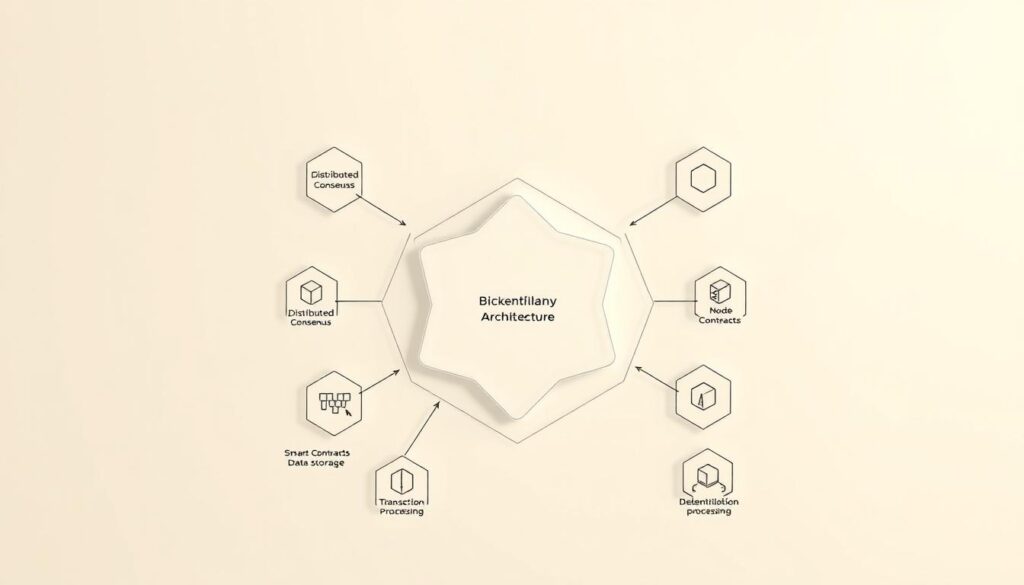Now Reading: Understanding Blockchain Architecture Explained for Beginners
- 01
Understanding Blockchain Architecture Explained for Beginners
Understanding Blockchain Architecture Explained for Beginners

Let’s explore the design behind a powerful new kind of digital record-keeping. This system connects computers in a peer-to-peer network, working together without a central boss.
Unlike traditional databases controlled by one company, this structure is decentralized. Every participant has a copy of the entire record. This removes single points of failure.
The technology creates a secure, unchangeable ledger. It uses advanced cryptography to link blocks of data into a continuous chain. This ensures information remains trustworthy and intact.
Understanding this foundation is crucial. It powers innovations in finance, supply chains, and beyond. This guide will walk you through the core components in simple terms.
Key Takeaways
- Blockchain architecture is a decentralized design for a network of computers.
- It operates without a central authority, making the system more resilient.
- The technology links data into a secure, unchangeable chain of records.
- This structure provides enhanced security by eliminating single points of failure.
- Grasping these basics is essential for understanding modern digital innovations.
Introduction to Blockchain Technology
At its core, this technology represents a fundamental shift in how we manage and verify digital information. It moves away from centralized control towards a system built on collective participation and trust.
What is Blockchain?
Think of it as a distributed digital ledger. This ledger records transactions across many computers. The record is extremely difficult to change once it is added.
A helpful analogy is Google Docs. Multiple people can edit the same document at the same time. Everyone sees the same version. This technology works in a similar way, but with much stronger security guarantees.
Origins and Evolution
The concept was first described in 1991. Researchers wanted a way to timestamp digital documents to prevent backdating. The idea was cryptographically secure but not widely used.
Everything changed in 2008. A person or group known as Satoshi Nakamoto adapted the technique. They created Bitcoin, the first successful application of this new system.
The table below highlights the key differences between traditional and distributed systems:
| Feature | Traditional Centralized System | Distributed Ledger Technology |
|---|---|---|
| Control | Single authority | Network participants |
| Data Storage | Central server | Copied across all nodes |
| Transparency | Limited | High |
| Security Focus | Perimeter defense | Cryptographic integrity |
This approach offers significant advantages. It improves operational efficiency and can reduce costs. The system provides greater accountability and trust for all users.
Fundamental Components of Blockchain Architecture
To comprehend how decentralized networks function, we must examine their essential building blocks. These core components work together to create a secure and transparent system.
Nodes, Blocks, and Transactions
Nodes are the individual computers that form the network’s foundation. Each node maintains a complete copy of the entire ledger. This distributed approach ensures system resilience.
Transactions represent the smallest units of activity within the system. They record transfers of value or changes to digital agreements. Multiple transactions get grouped together into blocks for processing.
Blocks serve as containers that batch these transactions. The network verifies each block before adding it to the chain. This verification process maintains data integrity across all nodes.

Decentralized Ledgers and Cryptography
The decentralized ledger stores the complete history from the first block to the current one. This chain structure creates an unbroken record of all activities. Each new block references the previous block through cryptographic links.
Cryptography provides the security foundation for the entire system. Public and private keys enable secure transactions and identity verification. The unique hash of each block acts like a digital fingerprint.
This combination of components creates an immutable record system. Changing any data would require altering all subsequent blocks. The architecture ensures trust through mathematical certainty rather than centralized authority.
Blockchain Network and Data Security
The resilience of a decentralized system stems from its robust network security protocols. These mechanisms ensure every participant agrees on the ledger’s state. This agreement prevents fraud and maintains trust across the entire network.
Consensus Mechanisms in Blockchain
Consensus protocols are the fundamental rules that govern how nodes validate transactions. They require widespread agreement before adding any new data to the chain. This process is vital for the system’s integrity.
Proof of Work is a well-known consensus method. It intentionally slows down block creation to enhance security. Miners compete to solve complex puzzles, and the winner adds the next block.
An alternative is Proof of Stake. Here, validators lock up, or “stake,” their own digital assets to earn verification rights. This creates a strong economic incentive for honest behavior within the network.

| Feature | Proof of Work | Proof of Stake |
|---|---|---|
| Primary Resource | Computational power | Staked cryptocurrency |
| Energy Consumption | High | Low |
| Security Basis | Cost of hardware & electricity | Economic value at risk |
| Block Creation Speed | Slower (e.g., ~10 minutes) | Faster |
Cryptographic Techniques for Integrity
Cryptography is the backbone of data security. It authenticates participants and protects transaction information from tampering. Every action on the network relies on these advanced techniques.
A cryptographic hash function acts like a unique digital fingerprint for each block. Algorithms like SHA-256 generate a long string of letters and numbers. If any data inside a block changes, its hash changes completely.
This makes tampering immediately obvious to all nodes. The combination of consensus and cryptography creates a powerful security model. It ensures the ledger remains an immutable and trusted record.
Understanding Blockchain Layers
The technology’s complex system can be best understood by examining its layered structure. This approach breaks down the entire framework into manageable parts. Each part has a specific role, working together to create a secure and functional whole.
Think of it like building a house. You need a foundation, walls, plumbing, wiring, and finally, the interior design. Similarly, this system relies on five key tiers:
- Hardware Layer: The physical computers (nodes) that power the network.
- Data Layer: Stores all transaction details and links between blocks.
- Network Layer: Manages communication between all the different nodes.
- Consensus Layer: Validates new blocks according to specific rules.
- Application Layer: The user interface for wallets and decentralized apps.
Hardware and Data Layers
The hardware tier forms the physical backbone. It consists of all the individual computers, or nodes, connected to the system. These devices provide the computational power needed to process and record activity.
Sitting directly above is the data tier. This is where the permanent record lives. It securely holds transaction information, including sender and receiver details. It also creates the cryptographic links that chain blocks together.
Network and Application Layers
The network tier is the communication hub. It ensures that information about new transactions and blocks spreads quickly to every node. This peer-to-peer interaction is vital for maintaining a single, agreed-upon truth.
At the very top is the application tier. This is the part users directly interact with. Developers build services like crypto wallets and DeFi platforms on this level. It turns the underlying technology into practical tools.
blockchain architecture explained for beginners
Imagine a digital orchestra where every instrument plays in perfect harmony to create an unbreakable record. Each component has a specific role, working together to achieve the system’s unique characteristics.
The design relies on fundamental data structures that form the backbone of the entire system. Two key elements create the chain-like structure: pointers and linked lists.

Pointers act as directional markers within each block. They contain information about the location of the previous block through its cryptographic hash. This creates a secure reference point.
Linked lists form sequences where each block contains its own data plus a reference to the next block. This creates an unbreakable chain of information that grows in sequential order.
Every block in the chain contains a batch of verified transactions. These are added in chronological sequence, creating a permanent record. The system stores this information as flat files or simple databases.
The combination of cryptographic linking and consensus mechanisms transforms basic storage into a secure distributed ledger. This architecture ensures transactions remain visible to all participants while being impossible to alter.
This design creates a system that is both transparent and secure. Understanding how these components work together provides a complete picture of this revolutionary technology.
Exploring Different Types of Blockchain Architectures
The landscape of decentralized networks encompasses several distinct configurations, each tailored to specific requirements. Different models serve various organizational needs and use cases.

Public Blockchain Systems
Public systems operate as completely open networks. Anyone can join without permission, view all transactions, and operate nodes.
These peer-to-peer networks prioritize decentralization and transparency. They don’t rely on central authorities, ensuring resistance to censorship.
Private and Consortium Models
Private systems restrict access to pre-approved participants. This controlled environment offers better privacy and faster transaction speeds.
Consortium models represent a hybrid approach. Multiple organizations jointly govern the network, balancing decentralization with practical business needs.
| Feature | Public | Private | Consortium |
|---|---|---|---|
| Access | Anyone | Selected members | Multiple organizations |
| Control | Decentralized | Single entity | Group governance |
| Speed | Slower | Faster | Moderate |
| Privacy | Low | High | Medium |
Choosing between these types depends on specific needs for transparency, control, and performance. Each architecture serves different purposes effectively.
Real-World Applications of Blockchain Technology
The true power of this distributed ledger system emerges when we see it solving real-world challenges. It moves beyond theory into practical solutions across many industries.
This technology streamlines operations and builds trust without middlemen. Companies use it to create faster, more secure processes.
Finance, Supply Chain, and Beyond
In finance, this system powers cryptocurrencies and enables rapid cross-border payments. It also creates new models like decentralized finance (DeFi). These applications remove traditional intermediaries.
Supply chains gain immense transparency. Every step of a product’s journey is recorded immutably. This helps verify authenticity and drastically reduces fraud.
Healthcare uses the technology to secure patient records. It allows safe data sharing between providers. This ensures privacy and integrity for sensitive information.
| Industry | Primary Application | Key Benefit |
|---|---|---|
| Finance | Cross-border payments, DeFi | Speed, disintermediation |
| Supply Chain | Product tracking & verification | Transparency, fraud reduction |
| Healthcare | Secure patient data management | Privacy, integrity |
| Real Estate | Property title management | Clear ownership records |
Smart Contracts and Decentralized Apps
Smart contracts are self-executing agreements with terms written in code. They automatically enforce conditions when predefined rules are met. This eliminates the need for manual oversight in contracts.
They revolutionize processes like insurance claims and royalty distribution. Users interact with them using a unique cryptographic private key. This key authorizes all transactions and proves ownership of digital assets.
The application layer hosts decentralized apps (DApps). These include NFT marketplaces and crypto wallets. Mastering the underlying blockchain development principles is key to building these powerful tools.
Your wallet address and private key are essential for engaging with this ecosystem. They secure your identity and assets within the decentralized system.
Best Practices for Building Blockchain Systems
Building a successful distributed ledger system requires careful planning and technical expertise. The implementation process involves critical decisions that determine whether your project will thrive or fail.
Thorough preparation is essential before writing any code. You must define the network infrastructure and choose between creating a new chain or using established platforms.
Design Considerations and Scalability
Your design must address specific business requirements and user roles. Think through system workflows and how users will interact with information.
Scalability presents a major challenge. The system must balance decentralization, security, and transaction throughput. Decisions about block size and creation timing directly impact performance.
Consensus mechanism selection is fundamental. This choice affects transaction speed, energy use, and security models. Different rules suit different applications.
Developers need expertise in cryptography, distributed systems, and data structures. Programming languages like Python, Java, and C++ are commonly used.
Security considerations must be integrated throughout the design process. Protect private keys and prevent smart contract vulnerabilities.
Governance models determine how the network handles upgrades and rule changes. Plan for evolution from the beginning.
Finally, assess whether this technology is truly appropriate for your needs. Sometimes traditional databases offer better efficiency for specific use cases.
Conclusion
Navigating the world of decentralized technology begins with grasping its underlying framework. Understanding this blockchain architecture is essential for anyone exploring its potential applications. The knowledge empowers informed decisions about implementation.
The core components work together to create resilient systems. Nodes, blocks, and cryptographic security form the foundation. Consensus protocols and distributed ledgers ensure trust and integrity across the network.
Different types of this structure serve various needs. Public, private, and consortium models offer flexibility. This technology provides solutions where traditional databases fall short.
Continue building on this foundational knowledge. Explore existing platforms and stay current with innovations. The unique combination of decentralization and security makes this system truly transformative.
FAQ
What are the core components of a blockchain system?
The main parts include nodes, which are computers on the network, and blocks, which are containers for data. Each block holds a list of transactions and a unique hash that links it to the previous block, forming a secure chain.
How does a blockchain network achieve security?
Security comes from a combination of cryptography and consensus protocols. Every transaction is encrypted, and all nodes must agree on the state of the ledger before new blocks are added, making tampering extremely difficult.
What is the difference between a public and a private blockchain?
A public blockchain, like Bitcoin, is open for anyone to join and participate. A private blockchain is permissioned, controlled by a single organization. A consortium blockchain is managed by a group of organizations, offering a middle ground.
What role do smart contracts play in this technology?
A: Smart contracts are self-executing agreements written in code. They live on the blockchain network and automatically enforce terms when predetermined conditions are met, enabling decentralized apps and automating transactions without intermediaries.
Why is the concept of decentralization so important?
Decentralization means no single entity controls the system. The ledger is copied across all nodes in the peer-to-peer network. This removes central points of failure and increases trust, as the data is transparent and verified by many participants.
How are new blocks created and added to the chain?
The process depends on the consensus mechanism. In systems like Bitcoin, miners compete to solve complex puzzles to validate transactions and create new blocks. Once verified by the network, the block is added permanently to the chain.















